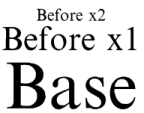<?rt>
Description
Specifies the start of ruby text, to be placed before the base text.
Example 504. Set ruby annotation with text before base text
Below is an example of a ruby annotation with text specified before the base text. In this case, the base text is 'Peter' and the ruby annotation before the base text is 'Name'.
<?ruby=1>Peter<?rt=1>Name<?rt=0><?ruby=0>
This example will produce the following result:
Example 505. Set nested levels of ruby annotation before base text
This syntax will produce nested levels of ruby annotations before the base text, with the text size reduced by 50% on each nested level:
<?ruby=1>Base<?rt=1><?ruby=1>Before x 1<?rt=1><?ruby=1>
Before x 2<?ruby><?ruby><?ruby>
This code will produce the following result:
Syntax
<?rt on off:o?>
<?rt>
[no parameter] | Specify the end of text to be used for ruby annotation |
on off | 1 | Specify the start of text to be used for ruby annotation | 0 | Specify the end of text to be used for ruby annotation |
|
Additional Information
There are several positions where the ruby text can appear relative to its base text. Because East Asian text may be rendered vertically as well as horizontally, the terms 'before' and 'after' are used rather than 'above' and 'below' or 'right side' and 'left side'. The words 'before' and 'after' should be understood as before / after the line containing the base text.
Sometimes more than one ruby text is associated with the same base text. A typical example is to indicate both meaning as well as reading for the same base text. In such cases, ruby texts may appear on both sides of the base text. Ruby text before the base text is often used to indicate reading; ruby text after the base text is often used to indicate meaning.
Related Links


